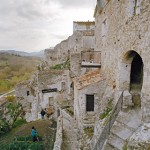Many donkeys-little donkeys across the leading article as you have never seen before. First thought was to publish the Austrian FELD72 group in this issue. Last autumn in Sofia, I had seen one of their presentations that among others included the project of a hotel named “Million Donkey”.
Even if we did not include this project into FELD72 file of this issue, please access the site www.milliondonkeyhotel.net, since it is taken into consideration as a policy of rescuing a rural area. Mid-way between architecture and artistic installation, the Million Donkey hotel was built in 24 days almost without a budget and includes a room where you can sleep in a quasi-flying bed (it slides out of the window, while at hot nights you can sleep hanging in the air), a bathroom located somewhere else, a bar and a siesta room. The entire project lays between the ruins of a former dwelling located in a village close to Napoli (Prata Sannita). A forgotten place, somehow properly unbound from civilization and for this reason, maybe, interesting for nowadays alternative travelers who need some cultural temptation, a landscape, an inspired name and a style of traveling. And the million donkeys to which the hotel name refers could have been most useful to carry wastes, building materials and furniture since car roads are rather absent in the area.
“La rue courbe est le chemin des ânes, la rue droite le chemin des hommes” (A curved road is a way for donkeys, while a straight road is a way for human beings), Corbusier said. Obviously, under such circumstances he would have realized that he had been wrong. On one hand, donkeys are rational since they know to choose a way down a smoothest slope, which means they manage to spare their efforts, and on the other hand, nearly hundred years further to this witticism we need carless spaces as much as we need air to breathe.
Speaking about journeys on narrow roads and not so straight to money, Sami Rintala, a Finnish architect is proposing a similar idea in the current issue: a tiny budget of about 15000 Euros, yet high-quality architecture. Instead of an official pompous sculpture, the outcome of this project is an installation-hotel including a reception and two rooms as well as a bathroom located within the police station nearby. Nevertheless, we follow this way of small-scale action not only via Rintala projects but also via Studio Basar and Yuri Awakumov ones. They all are expressive, pregnant, individual and condensed; a strategy to approach the job which fits for those who have something to say and do not wait for special opportunities, but create them.
I also remember Shrek, that cartoon film and the question is reasonable: what does Donkey from Shrek have to do with architectural phenomena? Well, it does since on the side of urban habits it is always better to choose the donkey instead of the ogre. The donkey wishes to turn away Shreck’s antisocial irrationality embodied by his love for whatever is green, for a complete nature he wants for himself only. Worst of all, he hates neighbors and on the whole, he does not need anything. Obviously, Shrek is not the image of the good peasant familiar with the village obedience and a simple life style, but he is actually the exponent of current rude suburbanites. Shrek-city would be an appropriate term to describe any dream of real estate development in the middle of nature that destroys nature on behalf of the love for nature and creates instead spaces where social isolation, lack of moral commitment, lack of interaction, diversity and social dynamism reign. I am taking this opportunity to thank the donkey in the film for having allowed me to launch this working concept – Shrek-city – which only now I understood as a genuine attitude opposing and showing aversion to the city.
As a sign of solidarity with these rational quadrupeds extremely useful for our job, I am inviting you to visit them in one of the abandoned donkey farms from UK or France or wherever they might be and at least adopt one on-line at either www.donkeyrescue.co.uk or www.neddi.org.
Photo: FELD 72


